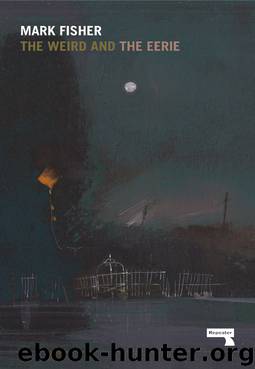The Weird and the Eerie by Fisher Mark;

Author:Fisher, Mark;
Language: eng
Format: epub
Tags: The Weird and the Eerie
ISBN: 4764136
Publisher: Watkins Media Ltd
Published: 2016-10-06T16:00:00+00:00
On Vanishing Land: M.R. James and Eno
As I mentioned in the introduction to this book, my thoughts on the eerie emerged from a collaborative project that I worked on with Justin Barton, On Vanishing Land. The eventual form that project took was a forty-five-minute audio-essay, but its origins came in a walk that we took in Suffolk, in the east of England, going from the coastal town of Felixstowe inland to Woodbridge. We were supposed to be scouting locations for another project, but the landscape demanded to be engaged with on its own terms. The symbolic markers of the beginning and ending of the journey were Felixstowe container port — an “unvisited vastness”, as Justin put it in the script for On Vanishing Land — and Sutton Hoo, the world-famous site of an Anglo-Saxon ship burial.
The port and the burial ground offer two different versions of the eerie. The container port looms over the declining seaside town, the port’s cranes towering above the Victorian resort like H.G. Wells’ Martian Tripods. Approached from the countryside, from Trimley marshes, the cranes preside over the rural scene like gleaming cybernetic dinosaurs erupting out of a Constable landscape. Viewed in this way, the port appears almost as a weird phenomenon, an alien and incommensurable eruption in the “natural” scene. Ultimately, however, it is the feeling of the eerie that is dominant. There’s an eerie sense of silence about the port that has nothing to do with actual noise levels. The port is full of the inorganic clangs and clanks that issue from ships as they are loaded and unloaded; what’s missing, at least for the spectator watching the port from a vantage point outside, are any traces of language and sociability. Watching the container lorries and the ships do their work, or surveying the containers themselves, the metal boxes racked up like a materialised version of the bar charts in Gibson’s cyberspace, their names ringing with a certain transnational, blank, Ballardian poetry — Maersk Sealand, Hanjin, K-line — one seldom has any sense of human presence. The humans remain out of sight, in cabs, in cranes, in offices. I’m reminded instead of the mute alien efficiency of the pod distribution site in Philip Kaufman’s 1978 version of Invasion of the Body Snatchers. The contrast between the container port, in which humans are invisible connectors between automated systems, and the clamour of the old London docks, which the port of Felixstowe effectively replaced, tells us a great deal about the shifts of capital and labour in the last forty years. The port is a sign of the triumph of finance capital; it is part of the heavy material infrastructure that facilitates the illusion of a “dematerialised” capitalism. It is the eerie underside of contemporary capital’s mundane gloss.
Sutton Hoo, meanwhile, is eerie in at least two different senses. Firstly, it constitutes a gap in knowledge. The beliefs and rituals of the Anglo-Saxon society that constructed the artefacts and buried the ship are only partly understood. (The
Download
This site does not store any files on its server. We only index and link to content provided by other sites. Please contact the content providers to delete copyright contents if any and email us, we'll remove relevant links or contents immediately.
4 3 2 1: A Novel by Paul Auster(12290)
The handmaid's tale by Margaret Atwood(7685)
Giovanni's Room by James Baldwin(7199)
Asking the Right Questions: A Guide to Critical Thinking by M. Neil Browne & Stuart M. Keeley(5657)
Big Magic: Creative Living Beyond Fear by Elizabeth Gilbert(5617)
Ego Is the Enemy by Ryan Holiday(5297)
The Body: A Guide for Occupants by Bill Bryson(4978)
On Writing A Memoir of the Craft by Stephen King(4866)
Ken Follett - World without end by Ken Follett(4647)
Adulting by Kelly Williams Brown(4489)
Bluets by Maggie Nelson(4479)
Eat That Frog! by Brian Tracy(4440)
Guilty Pleasures by Laurell K Hamilton(4363)
The Poetry of Pablo Neruda by Pablo Neruda(4041)
Alive: The Story of the Andes Survivors by Piers Paul Read(3970)
White Noise - A Novel by Don DeLillo(3956)
Fingerprints of the Gods by Graham Hancock(3943)
The Book of Joy by Dalai Lama(3904)
The Bookshop by Penelope Fitzgerald(3783)
